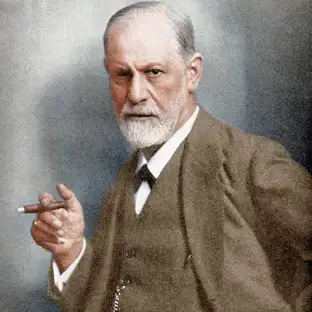Unlocking the Unconscious: Freud's Psychoanalytic Theory
Sigmund Freud
Sigmund Freu (/ˈzɪɡmʊnt frɔɪd/), born in 1856 in Austria, was a neurologist and the founder of psychoanalysis. He revolutionized the understanding of the human mind and its workings, introducing groundbreaking concepts like the unconscious, the id, ego, and superego, and the importance of childhood experiences in shaping personality.
graph TB
Freud["Sigmund Freud"]
Psychoanalysis["Psychoanalysis"]
Freud -->|Founder of| Psychoanalysis
Freud -->|Born in 1856 in Austria| FreudDetails["Neurologist and founder of psychoanalysis"]
Freud -->|Revolutionized understanding of the human mind| FreudConcepts["Introduced the unconscious, id, ego, and superego, \nimportance of childhood experiences"]
Psychoanalysis -->|Therapeutic method to explore and interpret the unconscious| Techniques["Techniques like dream analysis and free association"]
Techniques -->|Used to bring unconscious conflicts to conscious awareness for resolution| Resolution["Resolution of conflicts"]
style Freud fill:#FFD700,stroke:#000,stroke-width:2px
style Psychoanalysis fill:#FF6347,stroke:#000,stroke-width:2px
style FreudDetails fill:#FFD700,stroke:#000,stroke-width:2px
style FreudConcepts fill:#FFA500,stroke:#000,stroke-width:2px
style Techniques fill:#FF6347,stroke:#000,stroke-width:2px
style Resolution fill:#FF4500,stroke:#000,stroke-width:2px
Mind
graph LR
subgraph Conscious["Conscious"]
style Conscious fill:#FFF2CC,stroke:#D6B656
Thoughts["Thoughts"]:::thoughtsColor
Perceptions["Perceptions"]:::perceptionsColor
end
subgraph Preconscious["Preconscious"]
style Preconscious fill:#C2E0C6,stroke:#5FB483
Memories["Memories"]:::memoriesColor
StoredKnowledge["Stored Knowledge"]:::storedKnowledgeColor
end
subgraph Unconscious["Unconscious"]
style Unconscious fill:#E1D5E7,stroke:#9673A6
Fears["Fears"]:::fearsColor
ViolentMotives["Violent Motives"]:::violentMotivesColor
ImmoralUrges["Immoral Urges"]:::immoralUrgesColor
SelfishNeeds["Selfish Needs"]:::selfishNeedsColor
IrrationalWishes["Irrational Wishes"]:::irrationalWishesColor
ShamefulExperiences["Shameful Experiences"]:::shamefulExperiencesColor
UnacceptableSexualDesires["Unacceptable Sexual Desires"]:::unacceptableSexualDesiresColor
end
Thoughts --> Memories
Perceptions --> Memories
Memories --> Fears
Memories --> ViolentMotives
Memories --> ImmoralUrges
Memories --> SelfishNeeds
Memories --> IrrationalWishes
Memories --> ShamefulExperiences
Memories --> UnacceptableSexualDesires
style Thoughts fill:#FFD700,stroke:#333,stroke-width:2px
style Perceptions fill:#FFA500,stroke:#333,stroke-width:2px
style Memories fill:#98FB98,stroke:#333,stroke-width:2px
style StoredKnowledge fill:#20B2AA,stroke:#333,stroke-width:2px
style Fears fill:#FF6347,stroke:#333,stroke-width:2px
style ViolentMotives fill:#FF4500,stroke:#333,stroke-width:2px
style ImmoralUrges fill:#DB7093,stroke:#333,stroke-width:2px
style SelfishNeeds fill:#FF1493,stroke:#333,stroke-width:2px
style IrrationalWishes fill:#FF69B4,stroke:#333,stroke-width:2px
style ShamefulExperiences fill:#C71585,stroke:#333,stroke-width:2px
style UnacceptableSexualDesires fill:#8B008B,stroke:#333,stroke-width:2px
The Conscious
The conscious mind encompasses everything that we are aware of at any given moment. This includes our current thoughts, perceptions, and feelings. It is the aspect of our mental processing that we can think about and discuss rationally.
- Thoughts: These are the ideas and considerations actively occupying our minds.
- Perceptions: These are our interpretations of sensory information from our environment.
The Preconscious
The preconscious contains thoughts and feelings that are not currently in our conscious awareness but can be brought to consciousness easily. It serves as a bridge between the conscious and unconscious parts of the mind.
- Memories: These are past experiences that can be recalled when needed.
- Stored Knowledge: This includes learned information and skills that we can access when necessary.
The Unconscious
The unconscious mind is the largest and most enigmatic part of Freud’s model. It comprises thoughts, memories, and desires that are outside of conscious awareness but still influence our behavior and emotions. The contents of the unconscious are often disturbing or socially unacceptable, leading to their repression.
- Fears: Deep-seated anxieties that influence our behavior.
- Violent Motives: Aggressive impulses kept out of conscious awareness.
- Immoral Urges: Desires that conflict with societal norms and personal ethics.
- Selfish Needs: Strong desires for self-gratification that are socially unacceptable.
- Irrational Wishes: Desires that do not align with rational thought or reality.
- Shameful Experiences: Past events that cause feelings of shame.
- Unacceptable Sexual Desires: Sexual urges that are considered taboo.
Interaction Between the Parts
Freud’s theory suggests that the different parts of the mind interact dynamically:
- Conscious Thoughts and Perceptions can trigger memories in the preconscious.
- Memories in the Preconscious can influence the unconscious, leading to the emergence of repressed fears, motives, and desires.
Personality Structure
graph TD;
subgraph Id["Id"]
style Id fill:#F5B7B1,stroke:#C0392B
BasicNeeds["Basic Needs"]
Instincts["Instincts"]
PleasurePrinciple["Pleasure Principle"]
end
subgraph Ego["Ego"]
style Ego fill:#AED6F1,stroke:#2980B9
RealityPrinciple["Reality Principle"]
Balance["Balances Id and Superego"]
Rationalizes["Rationalizes Instincts"]
SelfPerception["Self-Perception"]
end
subgraph Superego["Superego"]
style Superego fill:#D7BDE2,stroke:#8E44AD
MoralPrinciples["Moral Principles"]
Ethics["Ethics of Thoughts and Actions"]
SocialAcceptance["Social Acceptance"]
SenseOfGuilt["Sense of Guilt"]
ExternalInfluences["External Influences"]
end
Id -->|Impulses| Ego
Superego -->|Moral Standards| Ego
Ego -->|Balances| Id
Ego -->|Balances| Superego
Id --> BasicNeeds
Id --> Instincts
Id --> PleasurePrinciple
Ego --> RealityPrinciple
Ego --> Balance
Ego --> Rationalizes
Ego --> SelfPerception
Superego --> MoralPrinciples
Superego --> Ethics
Superego --> SocialAcceptance
Superego --> SenseOfGuilt
Superego --> ExternalInfluences
Id: The most primitive part of the personality, driven by the pleasure principle. It seeks immediate gratification of basic needs and desires, such as hunger, thirst, and sexual urges. It is impulsive, irrational, and unconscious.
Ego: The mediator between the Id and the Superego, operating on the reality principle. It seeks to satisfy the Id’s desires in socially acceptable ways. It is rational, logical, and conscious.
Superego: The moral compass of the personality, driven by the morality principle. It represents internalized ideals and values learned from parents and society. It strives for perfection and adherence to social norms. It is both conscious and unconscious.
Overall
Freud’s work has had a profound and lasting impact on psychology. While his theories have their flaws and limitations, they opened up new avenues for understanding the human mind and the complexities of behavior. Many of his concepts have been refined and integrated into modern psychotherapy practices, while others have been discarded or revised.
graph LR
FreudCriticisms["Criticisms of Freud's Theories"]
FreudCriticisms --> OveremphasisSexuality["Overemphasis on Sexuality"]
FreudCriticisms --> LackScientificRigor["Lack of Scientific Rigor"]
FreudCriticisms --> Unfalsifiability["Unfalsifiability"]
FreudCriticisms --> BiasSubjectivity["Bias and Subjectivity"]
FreudCriticisms --> LimitedSample["Limited Sample"]
FreudCriticisms --> NeglectChildhoodTrauma["Neglect of Childhood Trauma"]
FreudCriticisms --> GenderBias["Gender Bias"]
FreudCriticisms --> PseudoscientificMethods["Pseudoscientific Methods"]
style FreudCriticisms fill:#FFD700,stroke:#333,stroke-width:2px
style OveremphasisSexuality fill:#FF6347,stroke:#333,stroke-width:2px
style LackScientificRigor fill:#87CEEB,stroke:#333,stroke-width:2px
style Unfalsifiability fill:#FFA500,stroke:#333,stroke-width:2px
style BiasSubjectivity fill:#98FB98,stroke:#333,stroke-width:2px
style LimitedSample fill:#DB7093,stroke:#333,stroke-width:2px
style NeglectChildhoodTrauma fill:#FF4500,stroke:#333,stroke-width:2px
style GenderBias fill:#8B008B,stroke:#333,stroke-width:2px
style PseudoscientificMethods fill:#C71585,stroke:#333,stroke-width:2px
It’s important to approach Freud’s work with a critical eye, acknowledging both its contributions and its shortcomings. His ideas continue to spark debate and research, demonstrating their enduring relevance in the ongoing exploration of the human psyche.
